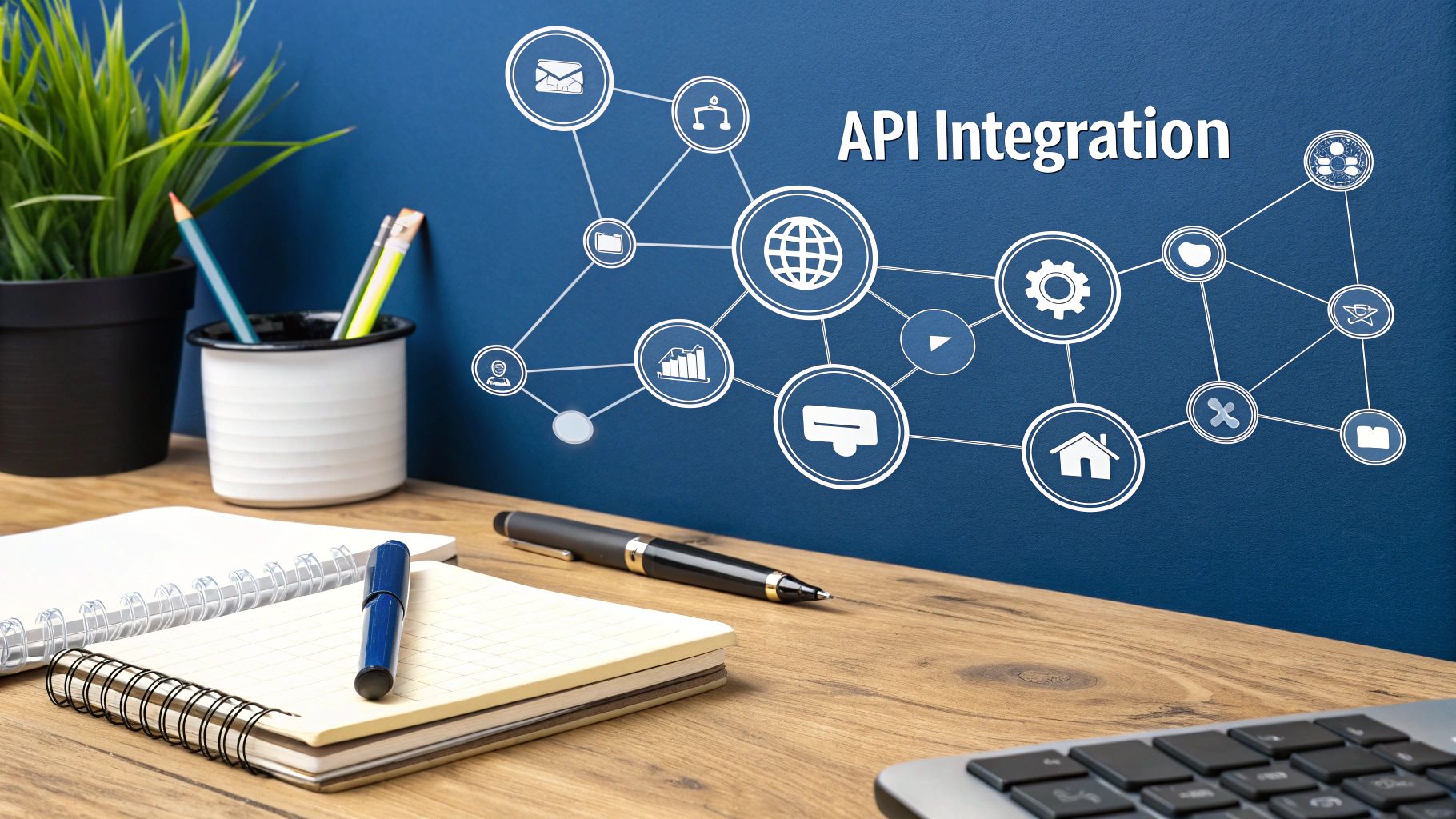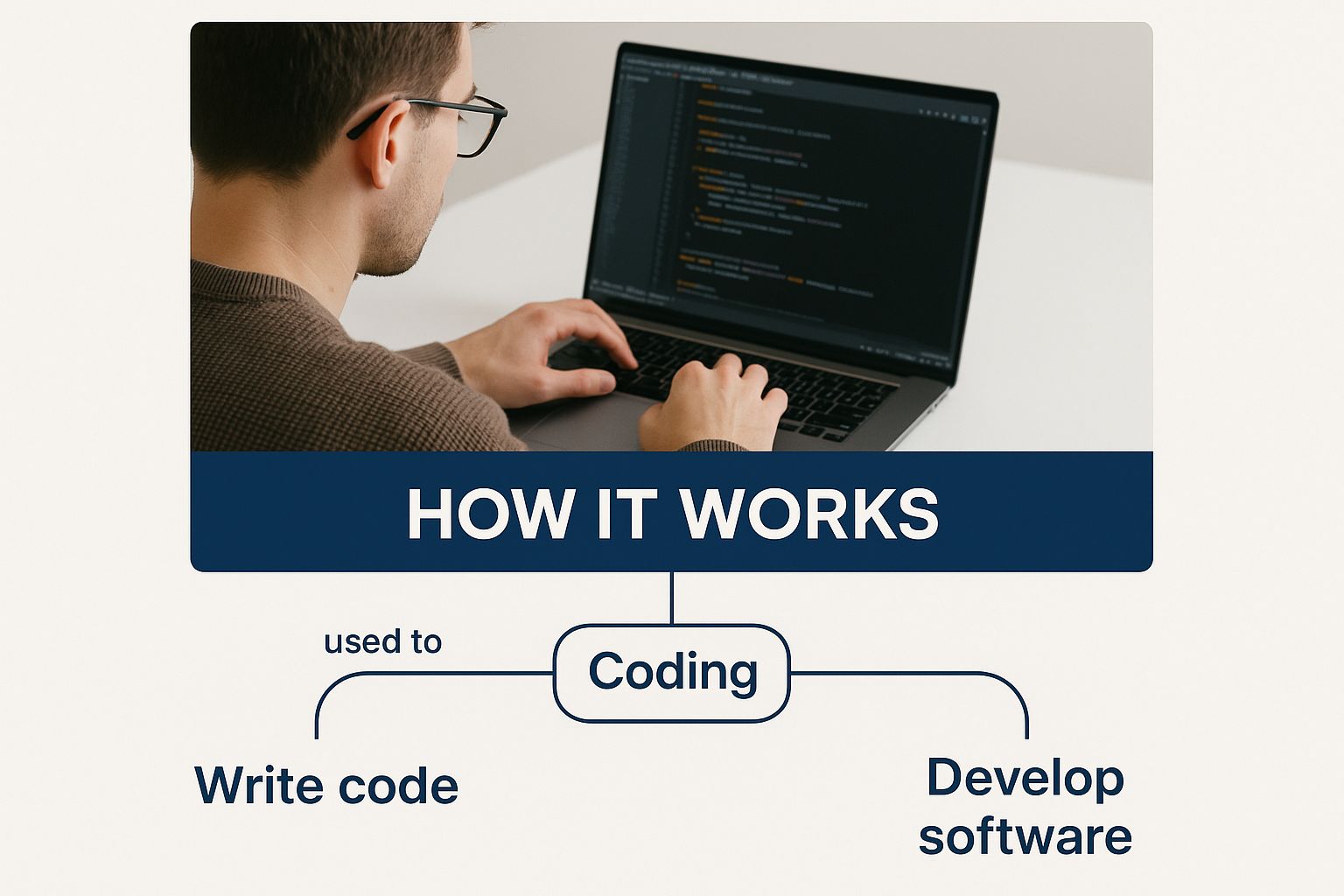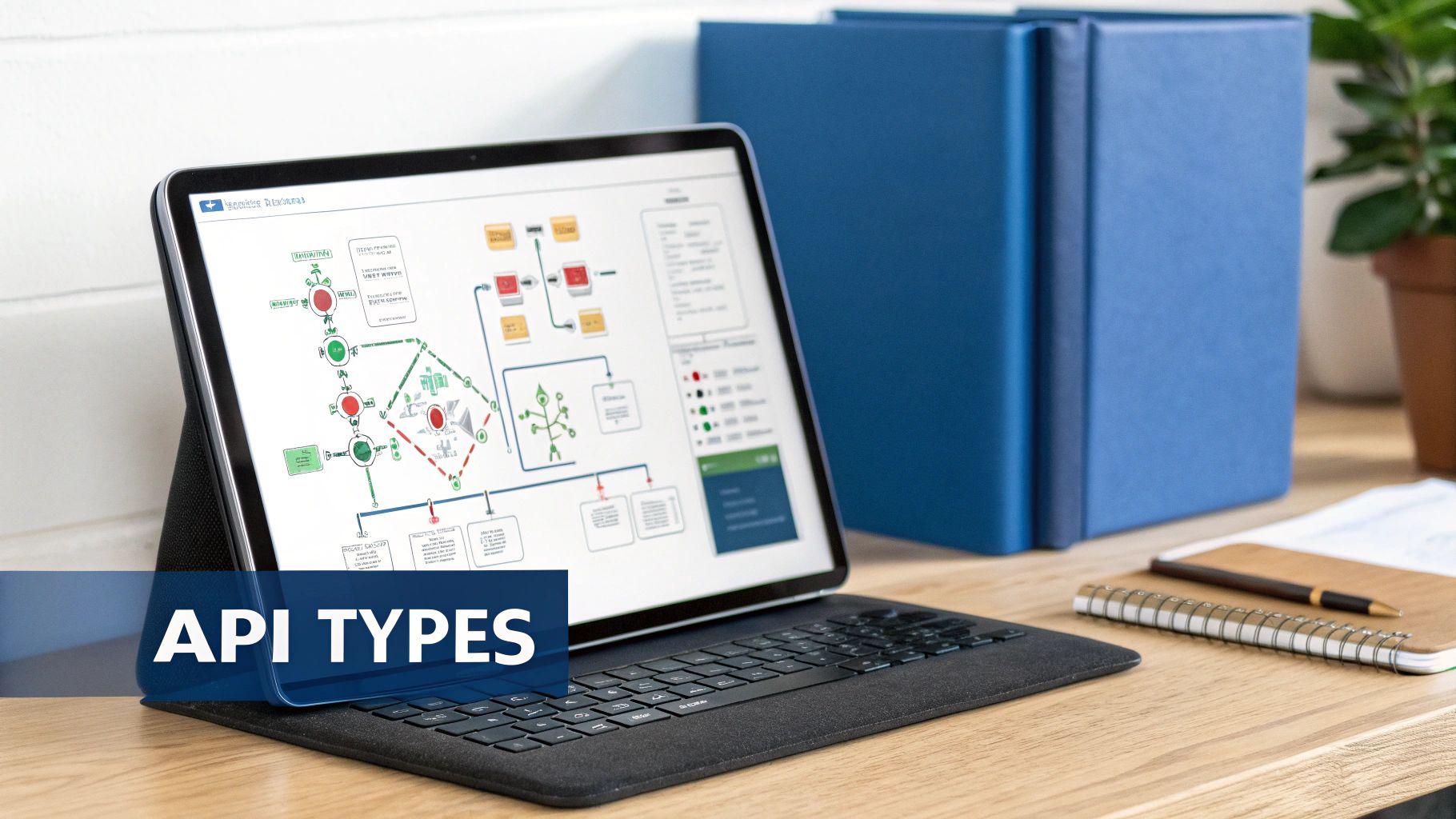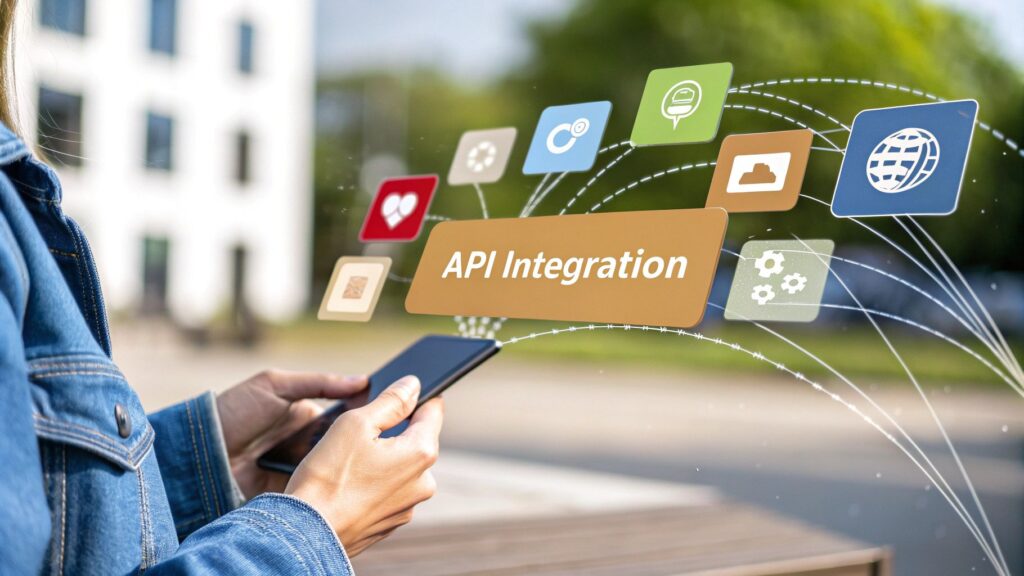Ever wonder how your favorite apps “talk” to each other? That behind-the-scenes magic is called API integration.
Simply put, API integration is the process of connecting different software applications through their APIs (Application Programming Interfaces). Think of it as building an invisible bridge that allows separate systems to share data and automate processes. It’s what lets your various tools work together like a well-oiled team instead of in isolated silos.
How API Integration Actually Works

To really get what API integration is, let’s use a simple analogy everyone can relate to: ordering food at a restaurant. You don’t just wander into the kitchen and start making your own meal. Instead, you give your order to a waiter, who then communicates your specific request to the kitchen and brings the finished dish back to your table.
In this scenario, the API is the waiter. It’s the messenger that takes a request from one application, delivers it to another system to fetch data or trigger an action, and then returns a response. The work of setting up these digital “waiters” to communicate between different software is API integration.
The Key Players in an Integration
This whole process relies on a few key components working together seamlessly. Without them, the smooth data sharing we often take for granted just wouldn’t happen. The integration’s job is to make sure every piece of software understands the other’s language and rules.
Here’s a quick breakdown of what’s happening in that restaurant analogy:
- The User Application: This is you, the customer placing an order. It’s the app that needs something from another service.
- The API Call: This is the actual order you give the waiter. It’s a structured request sent from your app to the other system’s API.
- The External Server: This is the kitchen. It’s the system that receives the request and holds the data or functionality you need.
- The API Response: This is the meal arriving at your table. It’s the data or confirmation sent back to your original application.
This core concept applies to all sorts of real-world scenarios, like using a Marketing Automation API to connect various marketing tools and make campaigns run more smoothly.
To give you a clearer picture, this table breaks down the core components of API integration and how they relate to our restaurant analogy.
API Integration at a Glance
| Component | Restaurant Analogy | Technical Function |
|---|---|---|
| API | The Waiter | Acts as the intermediary, carrying requests and responses. |
| User Application | The Customer | The starting point; the software initiating the request. |
| API Call | The Order | The specific request for data or an action sent to the server. |
| External Server | The Kitchen | The system that processes the request and holds the resources. |
| API Response | The Meal | The data or confirmation returned to the user application. |
As you can see, each piece has a distinct and essential role in making the whole system work.
By connecting these otherwise separate systems, API integration creates a single, unified environment where data can flow freely. This gets rid of tedious manual data entry, cuts down on errors, and opens the door to powerful automations that save businesses a massive amount of time and money.
How APIs Actually Work Under the Hood
Alright, enough with the analogies. To really get what API integration is, we need to peek behind the curtain at the actual mechanics. When one application talks to another, it’s not a casual chat. It’s a very specific, rule-based conversation that makes sure information is swapped securely and correctly every single time.
This structured communication depends on a few core components working in harmony. Each piece has a specific job, from telling the request where to go to making sure the receiving system understands what’s being asked. Once you get these parts, the magic of how software connects starts to make a lot more sense.
This graphic gives a great visual breakdown of how these pieces fit together during a typical API interaction.

As you can see, it’s a clear cycle: a request goes out, and a response comes back, all managed by a few key technical elements.
The Anatomy Of An API Call
At its core, an API call is just a well-structured message that a client application sends to a server. For the message to get where it’s going and be understood, it has to be formatted correctly and sent to the right “address.” Think of it like mailing a package—you need the correct street address, a clear note inside saying what you want, and a return address so they know who sent it.
This process breaks down into a few main parts:
- Endpoints: An endpoint is the specific URL where an API can be accessed. If the whole API is a restaurant menu, an endpoint is the exact dish you want to order. A weather app’s API, for instance, might have one endpoint for today’s forecast and a totally different one for historical weather data.
- Requests: This is the “ask.” A client sends a request to the endpoint, and this message includes a method (like GET to retrieve data or POST to submit new data), headers (which contain extra info like metadata), and sometimes a body (the actual data being sent).
- Responses: Once the server gets the request and does its thing, it sends back a response. This includes a status code (like the famous 200 OK for success or the dreaded 404 Not Found for an error) and, hopefully, the data you asked for.
The Language And Security Of APIs
For any two systems to talk, they need to speak the same language and trust each other’s identity. This is where data formats and authentication step in. Without these standards, API integrations would be a chaotic, insecure mess. For anyone building more advanced systems, getting these elements right is where a solid background in custom web app development really shines.
JSON (JavaScript Object Notation) is pretty much the go-to data format for modern APIs. It’s lightweight and easy for both people and machines to understand, which makes it ideal for shipping data between servers and apps.
Authentication is the final, crucial piece of this puzzle. It’s the process of verifying that the application making the request is actually allowed to. This is often handled with an API key—a unique string of characters that works like a secret password. When your app sends a request, it includes this key to prove to the server that it’s legit.
A core concept powering many modern integrations, especially those needing real-time updates, is event-driven programming. This model allows systems to react to new events as they occur, making the connection between applications far more dynamic and responsive.
Why API Integration Is a Must-Have for Any Modern Business

It’s one thing to understand the mechanics of an API, but the real magic happens when you see what they can do for your business. API integration isn’t some technical add-on anymore; it’s a fundamental strategy for anyone serious about growth, efficiency, and keeping customers happy. It’s what turns a jumble of separate software tools into a single, cohesive system that works for you.
At its core, API integration is all about automating how information flows between your systems. This simple act gets rid of soul-crushing manual data entry, which is not only a massive time-sink but also a huge source of errors. When your sales platform can instantly talk to your marketing tools and your support desk, everyone on your team gets a single, accurate picture of the customer. That means smarter decisions and way less time wasted on busywork.
Creating Better Customer Experiences
A smooth, hassle-free customer journey is one of the biggest advantages you can have over the competition, and API integration is how you build it.
Think about the last time you booked a vacation. You probably went to one website and booked your flight, hotel, and rental car all at once, right? You weren’t bounced around to a dozen different sites. That’s API integration in action, pulling data from multiple services into one simple, convenient place for you.
This kind of connected experience is what builds real loyalty. Customers love it when they don’t have to repeat themselves and when everything just works. For instance, custom HubSpot integrations can link your customer relationship management (CRM) software directly to your online store, so every interaction is backed by a full view of their purchase history and past support issues.
Driving Innovation and Staying Agile
Why spend months building every single feature from the ground up when you can just plug in services that are already the best at what they do? APIs let you embed powerful functions like payment processing, interactive maps, or even text messaging directly into your own products.
This approach dramatically speeds up development and frees up your team to focus on what makes your business unique. It’s also how you stay relevant. The API management market in the Middle East, for example, was valued at USD 56.99 million in 2024 and is expected to rocket to USD 151.29 million by 2030. That growth is being fueled by a clear understanding that connecting digital services is no longer optional. In fact, 83% of IT specialists in the region now consider API integration critical to their success.
API integration turns your technology stack from a group of isolated tools into a powerful, automated machine. It connects data, streamlines workflows, and ultimately enables your business to operate more intelligently and serve customers better.
Understanding the Different Types of APIs
Not all APIs are built the same, and API integration is definitely not a one-size-fits-all solution. The right type of API for any business really comes down to its goals—specifically, who needs access to the data and for what purpose. Getting a handle on these categories is key to understanding the strategy behind connecting different pieces of software.
Generally, APIs are grouped into three main types based on who can access them. Each serves a very different purpose, from tidying up your own internal processes to building a global community of developers.
Private APIs for Internal Efficiency
First up are Private APIs, which you might also hear called internal APIs. These are the unsung heroes working behind the scenes, built exclusively for use inside a single company. They aren’t exposed to the outside world at all; their whole job is to get a company’s own systems and applications talking to each other.
Imagine a big retail company. It could use a private API to make sure its inventory system automatically syncs up with the stock levels shown on its e-commerce site. Another private API might link its customer relationship management (CRM) platform with its internal accounting software, letting sales data flow right in without anyone having to type it out manually.
The main point of a Private API is to smooth out internal workflows, knock down data walls between departments, and just make the business run better. They help create a unified internal world where all the company’s different systems can communicate smoothly.
Partner APIs for Strategic Alliances
Next, we have Partner APIs. Just like the name implies, these APIs are shared with specific business partners, but they aren’t open to just anyone. Access is carefully managed, usually as part of a formal agreement, letting two companies create integrated services that help them both.
A classic example is the partnership between an airline and a hotel chain. The airline could give its hotel partner access to its booking API. This would allow the hotel’s website to let customers book a flight and a room at the same time, all in one package. It makes for a much better customer experience and opens up new ways for both companies to make money.
Public APIs for Widespread Innovation
Finally, there are Public APIs, also known as Open APIs. These are out there for any third-party developer to use. Companies publish them to spark innovation, expand the reach of their platforms, and grow a lively developer community around their services. The Google Maps API is a perfect example—it lets countless apps embed interactive maps for everything from driving directions to finding a nearby coffee shop.
This open-door approach is a huge force in modern business. In the Middle East and Africa, for instance, the open API market was valued at USD 51.56 million in 2024 and is expected to hit USD 143.79 million by 2033. This incredible growth shows just how much open APIs are fueling new ideas in banking, healthcare, and travel by giving developers the tools to build new, interconnected customer experiences. You can discover more insights about the open API market growth in the MEA region.
API Integration Examples You Use Every Day
The easiest way to really understand what API integration is comes from realizing how often you already use it. You probably interact with dozens of these connected systems every day without even thinking about it. This invisible network is what makes so much of our digital life feel smooth and connected.
Once you start looking for them, you’ll see these digital connections everywhere, passing information back and forth to make things work. The abstract idea of software talking to software becomes a lot clearer when you see it in action.
Secure Payments and E-commerce
Every time you buy something online, you’re watching a beautiful dance of API integrations. When you enter your credit card information on a Shopify store, for instance, the website itself doesn’t actually store or process that sensitive data.
Instead, it uses an API to securely pass the payment details to a trusted payment gateway like Stripe or PayPal. The gateway’s API takes over, processes the transaction, checks for available funds, and then sends a simple “success” or “fail” message back to the online store. This all happens in a blink, keeping your financial data safe and making the checkout process feel seamless. Well-executed Shopify integration services are the key to making this complex process feel completely effortless for the customer.
One-Click Logins and Social Sharing
Sick of creating yet another username and password for a new website? Those “Log in with Google” or “Sign in with Facebook” buttons are your best friends, and they run entirely on APIs.
When you click one of those buttons, the website uses an authentication API to essentially ask Google or Facebook, “Hey, can you confirm this person is who they say they are?” The social platform’s API verifies your identity on its end and sends a confirmation token back to the website, granting you access. You get in quickly without having to remember another password, and the website gets a verified user. It’s a win-win.
Travel Bookings and Aggregators
Planning a trip on a site like Expedia or Kayak is another perfect example. These platforms don’t own any airlines or hotels. What they do have is a powerful network of APIs that pull real-time data from hundreds of different travel providers.
When you search for a flight from Dubai to London, the aggregator’s system sends out dozens of API calls to various airline systems. It then gathers all the responses—flight times, prices, and availability—and neatly organizes them into one single list for you to browse.
Embedded Communication Features
APIs are also completely changing how we communicate. In the Middle East and Africa, telecommunications is a huge area for integration, with the Telecom Network API market valued at an estimated USD 6.51 billion in 2024.
Think about when your ride-sharing app lets you call your driver without ever leaving the app itself. That’s a telecom API at work, embedding calling functionality directly into another service. This market is poised for massive growth, all thanks to technologies that rely on APIs to weave voice and messaging features into other platforms. You can dig into more data on the growth of the Telecom Network API market to see just how fast it’s expanding.
Common Questions About API Integration
As you start wrapping your head around connecting different software, a few questions always seem to pop up. It’s totally normal. Getting these details straight can clear up any confusion and give you a much better feel for what API integration looks like in the real world.
Let’s walk through some of the most common questions people ask. We’ll break down the core difference between an API and an integration, talk about the all-important security side of things, and cover what it actually takes to build these connections.
What Is the Difference Between an API and an Integration?
This is easily the number one point of confusion, and it’s a great question because the distinction is crucial. The simplest way to think about it is this: an API is a tool, while an integration is the finished project you build with that tool.
An API (Application Programming Interface) is basically a set of rules and definitions that lets one piece of software talk to another. It’s the menu at a restaurant—it tells you what you can order and how to ask for it, but it’s not the meal itself. The API defines how the conversation can happen.
An API integration, on the other hand, is the actual process of using one or more APIs to make different systems work in harmony. It’s the act of building the bridge, not just having the blueprints. An integration might involve stringing together multiple API calls, translating data between systems, and setting up a workflow that automates a task from start to finish.
In short: An API is the language two systems use to talk, while an integration is the meaningful conversation they have to get something done.
How Secure Are API Integrations?
Security is non-negotiable, especially when you’re moving data between applications. A leaky API is a huge security risk, which is why modern API design is obsessed with keeping data locked down. Thankfully, there are rock-solid standards in place to make sure these connections are protected.
Most API integrations use a multi-layered security approach:
- Authentication: First, the API needs to confirm who is asking for the data. This is typically done with API keys—unique codes that act like a username and password for the software, proving it is who it says it is.
- Authorization: Once a system is authenticated, authorization determines what it’s allowed to do. Using protocols like OAuth 2.0, you can grant very specific permissions. For instance, an app might be allowed to read your contacts but not delete them. It’s like giving someone a key to your house but not the key to your safe.
- Encryption: Data is almost always scrambled during its journey between systems using TLS/SSL. This process, known as encryption in transit, makes the information unreadable to anyone trying to eavesdrop. Data is often encrypted “at rest” too, meaning when it’s stored on a server.
When these methods are combined, a well-built API integration is incredibly secure, keeping sensitive information safe as it flows between your tools.
What Skills Are Needed to Build an API Integration?
Building a basic API integration has gotten much easier over the years, but creating a truly solid, scalable connection still takes some real technical know-how. The difficulty can range from dragging and dropping in a low-code tool to writing a custom application from the ground up.
For those hands-on, custom-built integrations, here are the skills that really matter:
- Programming Proficiency: You need someone who can write code. A strong grasp of a language like Python, JavaScript (Node.js), or Java is fundamental for making the API calls and handling the data that comes back.
- Understanding of HTTP: Nearly all modern APIs are built on the web, so knowing how the HTTP protocol works is a must. This includes things like request methods (GET, POST), status codes (like the famous 404 “Not Found”), and headers.
- Data Handling: APIs communicate using specific data formats, and JSON is the king. A developer needs to know how to pull apart the JSON data returned by an API and restructure it for the receiving application.
- Security Best Practices: This one is huge. A developer has to know how to handle sensitive information like API keys and credentials, storing them securely so they don’t fall into the wrong hands.
While no-code platforms are empowering more people to build simple connections, complex or business-critical workflows still need skilled developers to make sure they’re reliable, secure, and efficient.
Ready to connect your business systems and automate your growth? Invocom specializes in creating powerful, custom API integrations that make your software work together seamlessly. Get in touch with our experts today!






